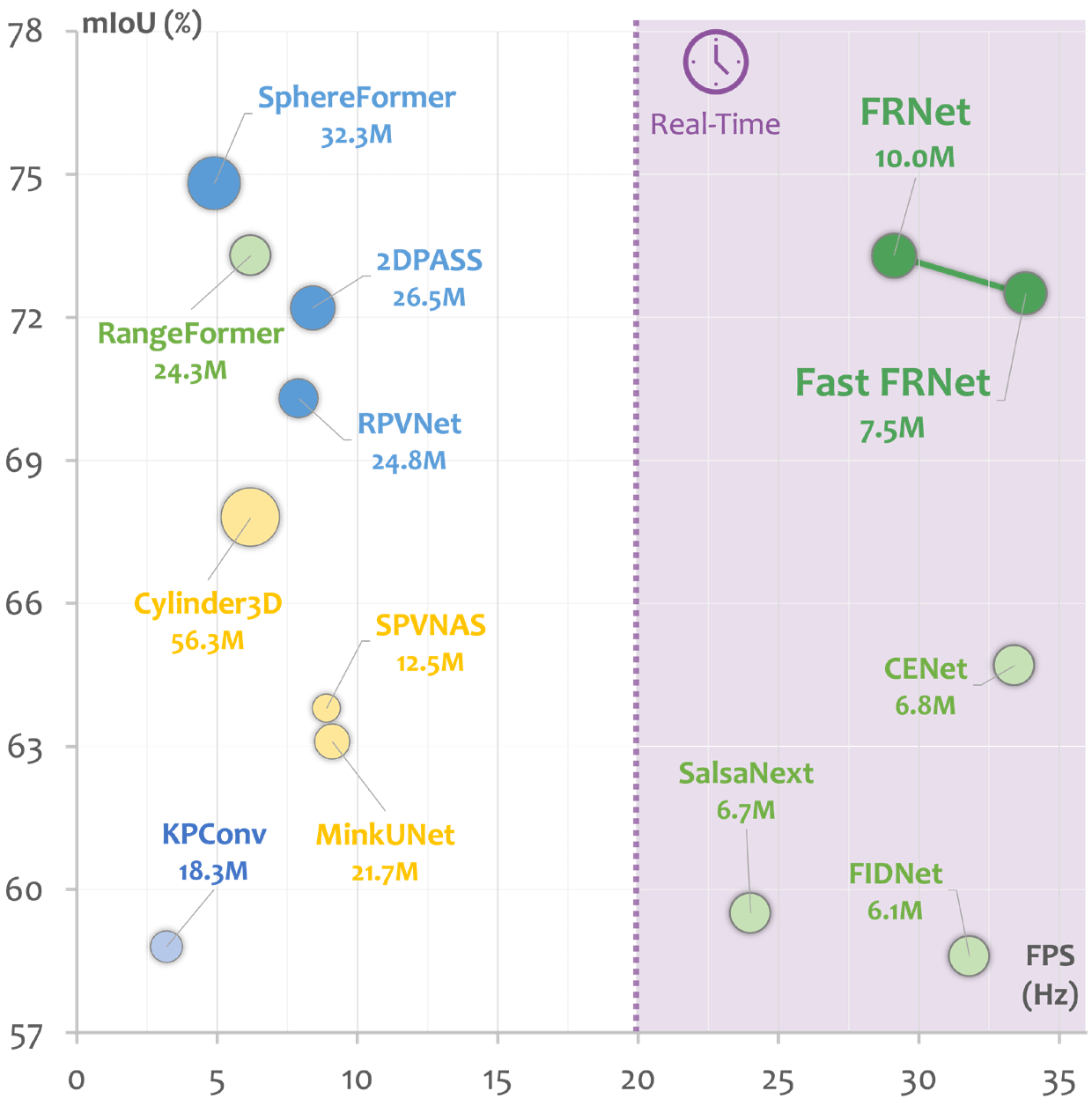1Nanjing University of Aeronautics and Astronautics 2National University of Singapore
3Nanjing University of Posts and Telecommunications
FRNet is a simple yet efficient network for LiDAR segmentation. It consists of three key components: 1) Frustum Feature Encoder; 2) Frustum-Point Fusion Module; and 3) Head Fusion Module. Moreover, we introduce two novel argumentations, FrustumMix and RangeInterpolation, to enrich the point cloud scenes.
FRNet achieves an appealing balance between accuracy and efficiency, enabling real-time LiDAR segmentation.
 |
 |
|---|---|
| Speed vs. Accuracy | Speed vs. Robustness |
Visit our project page to explore more examples. 🚗
- [2024.04] - We have further improved our manuscript and code.
- [2023.12] - We provide trained weights on SemanticKITTI and nuScenes. The checkpoints can be downloaded from here.
- [2023.12] - Our paper is available on arXiv, and the code is publicly available.
| Demo 1 | Demo 2 | Demo 3 |
|---|---|---|
 |
 |
 |
| [Link] | [Link] | [Link] |
Please refer to INSTALL.md for the installation details.
Please refer to DATA_PREPARE.md for the details to prepare the 1SemanticKITTI and 2nuScenes datasets.
Please refer to GET_STARTED.md to learn more usage of this codebase.
 |
|---|
| Method | Param | SemanticKITTI | nuScenes | ScribbleKITTI | SemanticPOSS | |||||
|---|---|---|---|---|---|---|---|---|---|---|
| FPS | Val | Test | Val | Test | mIoU | mAcc | mIoU | mAcc | ||
| CENet | 6.8 M | 33.4 | 62.6 | 64.7 | - | - | 55.7 | 66.8 | 50.3 | - |
| RangeViT | 23.7 M | 10.0 | 60.7 | 64.0 | 75.2 | - | 53.6 | 66.5 | - | - |
| Fast-FRNet | 7.5 M | 33.8 | 67.1 | 72.5 | 78.8 | 82.1 | 62.4 | 71.2 | 52.5 | 67.1 |
| FRNet | 10.0 M | 29.1 | 68.7 | 73.3 | 79.0 | 82.5 | 63.1 | 72.3 | 53.5 | 68.1 |
| Method | SemanticKITTI | nuScenes | ScribbleKITTI | |||||||||
|---|---|---|---|---|---|---|---|---|---|---|---|---|
| 1% | 10% | 20% | 50% | 1% | 10% | 20% | 50% | 1% | 10% | 20% | 50% | |
| Sup.-only | 44.9 | 60.4 | 61.8 | 63.1 | 51.9 | 68.1 | 70.9 | 74.6 | 42.4 | 53.5 | 55.1 | 57.0 |
| LaserMix | 52.9 | 62.9 | 63.2 | 65.0 | 58.7 | 71.5 | 72.3 | 75.0 | 45.8 | 56.8 | 57.7 | 59.0 |
| FrustumMix | 55.8 | 64.8 | 65.2 | 65.4 | 61.2 | 72.2 | 74.6 | 75.4 | 46.6 | 57.0 | 59.5 | 61.2 |
| Method | SemKITTI-C | nuScenes-C | ||
|---|---|---|---|---|
| mCE | mRR | mCE | mRR | |
| CENet | 103.4 | 81.3 | 112.8 | 76.0 |
| FRNet | 96.8 | 80.0 | 98.6 | 77.5 |
📝 Note:
- mCE (the lower the better): The average corruption error (in percentage) of a candidate model compared to the baseline model, which is calculated among all corruption types across three severity levels.
- mRR (the higher the better): The average resilience rate (in percentage) of a candidate model compared to its "clean" performance, which is calculated among all corruption types across three severity levels.
We provide the trained models for SemanticKITTI and nuScenes. The checkpoints can be downloaded from here.
This work is under the Apache 2.0 license.
If you find this work helpful, please kindly consider citing our paper:
@article{xu2023frnet,
title = {FRNet: Frustum-Range Networks for Scalable LiDAR Segmentation},
author = {Xu, Xiang and Kong, Lingdong and Shuai, Hui and Liu, Qingshan},
journal = {arXiv preprint arXiv:2312.04484},
year = {2023}
}This work is developed based on the MMDetection3D codebase.
MMDetection3D is an open-source object detection toolbox based on PyTorch, towards the next-generation platform for general 3D perception. It is a part of the OpenMMLab project developed by MMLab.
We acknowledge the use of the following public resources during the course of this work: 1SemanticKITTI, 2SemanticKITTI-API, 3nuScenes, 4nuScenes-devkit, 5ScribbleKITTI, 6SemanticPOSS, 7SemanticPOSS-API, 8Robo3D, 9PCSeg, 10SalsaNext, 11FIDNet, 12CENet, 13RangeViT, 14SphereFormer, 152DPASS, 16Cylinder3D, 17SPVNAS, 18KPConv, and 19LaserMix. 💟





